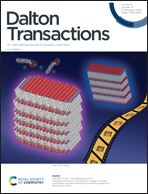α-Li2TiO3: a new ultrastable anode material for lithium-ion batteries†
Abstract
Herein, sol–gel-synthesized α-Li2TiO3 was evaluated as a new promising anode material for lithium-ion batteries. The results show ultrastable release of discharge capacity within the range of 290–350 mA h g−1 in 400 cycles. Decent rate performances were also observed. A capacity of ca. 113 mA h g−1 was retained at a current density of 3 C. A 2 × 2 × 1 supercell of the lowest energy ordering structure was used in density functional theory simulations. The calculations show that in the intercalation process, Li+ preferentially enters the tetrahedral voids, leading to the activation of lithium-ion diffusion on the a–b plane with a minimal energy barrier of 0.06 eV (compared with 0.82 eV for the fully charged state). The activation of cation mobility at Li+ intercalation and insulator–conductor transition both contribute significantly to the ultrastability of the material. However, Li+ propagation along the c-axis is highly limited during the whole intercalation process. The enumeration of all the ordering structures on the tetrahedral sites shows two intermediate phases, α-Li2.25TiO3 and α-Li3.0TiO3, as observed from the formation energy convex hull.



 Please wait while we load your content...
Please wait while we load your content...